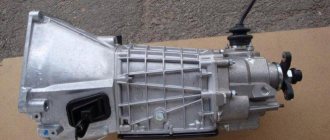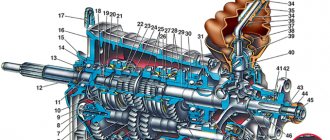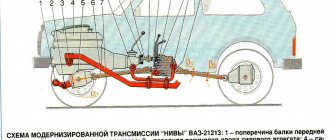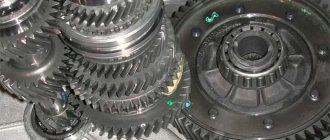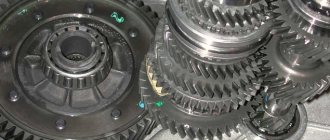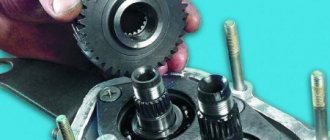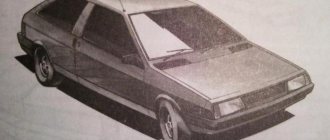I was already tired of the crunching sound when turning on second gear; of course, it did not appear suddenly immediately, but over time, from the beginning it was rare and then more and more often, and it also depended on the engine speed when switching (the higher it is, the more likely it is to appear). To avoid crunching, I had to engage the gear 2 seconds after squeezing the clutch, which is insanity, of course.
Everything would be fine, but that’s not all that bothered me; the reverse gear was often engaged with a crunch. There is also oil leakage from the side of the gearbox housing and a rather unpleasant rustling noise from the gearbox side, and it’s time to change the oil; it has already worked (in winter, in cold weather, the car tried to stall or go in neutral). The only conclusion is to remove and disassemble.
I filmed without a hole or an assistant, I drove the car onto a couple of planks and jacked it up
The fourteenth VAZ (like the VAZ 2113 and VAZ 2115) is equipped with a five-speed manual gearbox. This gearbox is similar to the units that were installed on the eight, but the main pair has been changed.
From this article you will learn the technical characteristics and design features of the gearbox on the VAZ 2114, how the repair and maintenance of the fourteenth gearbox is carried out, and what is the current cost of used and new units.
Disassembled gearbox
Troubleshooting
If the VAZ 2109 gearbox howls, then the simplest repair is to check the level and change the oil in the crankcase. To eliminate all other defects, it is necessary to remove the box from the car and completely disassemble it. To do this, you need a closed room, a large number of various tools and experience in repairing such units.
Lack of oil
The oil level is measured using a dipstick installed in the upper part of the gearbox housing. A volume located at any distance between the minimum and maximum marks on the probe rod is considered normal. On the oldest gearboxes that do not have an overdrive fifth gear, the amount of fluid is measured through a hole in the side, closed with a plug. The level should be at the bottom edge of this hole.
Dipstick for checking the oil level on the VAZ 2109 box
To maintain the normal condition of the oil, it should be changed after 75 thousand kilometers. When filling, use API GL-4 standard lubricants with a viscosity of 75W-90, 80W-85 or 80W-90. Some owners specially fill in thick oil of the TM-5 type, which reduces the noise of the box. If replacing the lubricant does not correct the situation and the mechanism continues to make noise, then the problem lies in worn-out gearbox parts.
Replacing the drive shaft bearing
Before replacing the bearings, the gearbox must be removed from the vehicle.
To remove the gearbox you must:
The procedure for removing the box from a VAZ 2109 is shown in the video from the author of AUTO REZ.
After completing the steps described above, you need to disassemble the gearbox and remove the input shaft.
To remove and replace worn bearings, follow the steps:
Wear of gears in the box
To perform the repair, you will need to remove the gearbox from the car according to the instructions described above and completely rebuild the gearbox. In this case, the condition of all parts of the mechanism should be assessed, since not only gears, but also other mechanisms can be worn out.
The sequence for disassembling the gearbox is as follows:
The procedure for disassembling the box is described in detail on the video of the AUTO RES channel.
The drive shaft of the VAZ 2109 box has several gears, one of which is made in the body of the shaft, and the second has a high interference fit. Therefore, the input shaft gears cannot be replaced and are replaced with a completely new shaft. Maintenance of this part consists of replacing the bearings, which are removed with mounting tools or a puller. Only the secondary shaft of the box can be disassembled, and the parts should be marked or laid out in the order of removal. This method makes it easier to reassemble the unit.
Shaft disassembly sequence:
Changing the synchronizer clutch
Work on replacing couplings is carried out on a disassembled box in the same way as changing blocking rings. After removing the clutch and hub assembly, it is necessary to disassemble this unit.
The video, made by user Sem, shows how you can quickly assemble a synchronizer.
Clutch adjustment
To adjust the clutch, do the following:
Measure the clutch pedal travel Unscrew the nuts securing the cable Adjust the cable
How to repair a gearbox on a VAZ 2107
A four-speed gearbox was installed on the “old” model VAZ, and a five-speed gearbox on the “new” model VAZ. However, working with both mechanisms is not much different from each other. The essence of the repair work is to perform the following steps:
- Removing the box from the car.
- Disassembling the gearbox into its component parts.
- Replacement of failed elements with new ones.
- Assembling the box.
- Installation of a gearbox on a car.
It should be noted that repairs should only begin if there are clear signs of a faulty box. As a preventive measure, it makes no sense to interfere with the structure of this mechanism again.
Preparing tools
To carry out all of the above work, you will need to prepare in advance:
- heads for 13 and 17;
- extension to the heads;
- Phillips screwdriver;
- flat screwdriver with a thin blade;
- flat screwdriver with a powerful flat blade;
- impact screwdriver;
- tweezers;
- wrenches 13 (2 pcs), 10, 17, 19 and 27;
- circlip puller (or pliers);
- hammer.
How to remove the gearbox
The box can only be repaired after it has been removed from the car, so you will need to be patient and time-consuming. Repairing a gearbox is clearly a difficult and slow task.
To remove the box from a VAZ 2107, you will need to drive the car into a pit or viewing platform. The jacking option will not work, since it will be impossible to complete all stages of the work:
- Remove the wire from the negative terminal of the battery.
- The first stage of work is carried out directly from the salon. For convenience, it is necessary to remove the panel in which the radio is located.
- Press the gear shift lever and insert a flat-head screwdriver into the hole in the gearbox locking sleeve.
- Using a screwdriver, pull the bushing towards you.
- Disconnect the rod from the gear shift lever.
- Use tweezers to hook the edge of the damper insert and remove it.
- Using two flat screwdrivers, press apart the petals of the damper insert and move them apart.
- Then remove the damper and bushings from the gear lever.
- In the cabin, move the foot mat near the gearbox.
- Using a Phillips screwdriver, unscrew the four screws on the box lid.
- Remove the cover from the gear shift lever.
- The second stage of work is carried out directly under the car. The first step is to remove the exhaust manifold pipe from the box.
- Disconnect the clutch mechanism.
- Immediately remove all connections from the gearbox (at the same time, you can check the integrity of the wires).
- Disconnect the cardan drive.
- Remove the flexible shaft mounting mechanism from the speedometer.
- Unscrew the two bolt connections on the side cover of the gearbox.
- Remove the box from the car.
- Place something strong and stable under the body of the box, as it may fall out.
Video: dismantling instructions
Attention! The gearbox on the VAZ 2107 weighs 23 kilograms (including oil), so it is recommended that it be dismantled by two people.
How to properly disassemble the box
Repair work on the gearbox is possible only after identifying the real cause of the breakdown. Therefore, it will be necessary to disassemble the device correctly and safely for each component of the box and perform troubleshooting.
To ensure the disassembly process goes quickly and without interference, it is recommended to immediately prepare the following tools:
- impact screwdriver;
- wrench 10;
- socket wrench 13;
- three-jaw puller;
- vice;
- tweezers;
- torque wrench.
Of course, as necessary, gaskets, oil seals, and those parts that were discarded during the work will be needed.
Operating procedure
Disassembling the box yourself in a garage is a completely doable task. However, the work will require maximum concentration and attention:
- After removing the gearbox from the car, it is recommended to wash the housing from dirt. You can even use kerosene or white spirit to ensure the surface of the box is clean.
- Remove the bell (casing).
- Turn the box over and unscrew the cover bolts.
- Remove the gear block plug from the rear cover.
- Pull out the retaining ring with tweezers.
- Press out the gear block bearing.
- Press out the reverse gear bearing.
- Remove the secondary shaft oil seal.
- Pull out the thrust washer from the rear bearing of the secondary shaft.
- Press out this bearing.
- Remove the speedometer drive gear and pull out the roller ball (clamp) behind it.
- Remove the gear fork mounting bolt.
- Block the shafts by inserting a thick bolt or a powerful screwdriver between them.
- While turning the input shaft, pull it towards you along with the gears and bearings.
- Then pull out the secondary shaft.
- The intermediate shaft comes out easily.
Device
The design of the VAZ-2114 transmission assumes the presence of the following elements:
- Box gears.
- Shafts. There are several of them. These are primary, secondary and intermediate.
- Synchronizers.
- Reverse gear. It consists of an additional gear and shaft.
- Gear shift lever.
- Transmission housing.
- Drain and filler hole for oil.
- Dipstick and breather.
The gear shift pattern is located on the lever.
As you can see, everything is quite simple and clear. By the way, the first generations of Samara used 4-speed gearboxes. But now they are rarely seen. So, let's take a closer look at the design of the VAZ-2114 Samara-2 gearbox. All main transmission components are contained in the crankcase. It is securely attached to the car engine. It also contains oil. When the gears operate, the gearbox teeth become very hot. Without lubrication, their service life is significantly reduced. Therefore, the crankcase contains from two to four liters of oil, depending on the type of car. For the VAZ-2114 gearbox, it is recommended to use 3.3 liters of gear lubricant. So, let's continue to study the device. As for the shafts, during operation of the unit they rotate in bearings and have a set of five gears with different gear ratios. To ensure that each gear is engaged clearly and smoothly, synchronizers are provided. They smooth out the shock from rotating gears when turning on a certain speed. Gear shifting is performed by the gearshift lever connected to the rocker. It is fed directly into the box. Also in the design of the transmission there is a locking device that prevents spontaneous switching off of the gear and a locking mechanism. It prevents several speeds in the box from turning on at once.
Inspection and repair
After dismantling, parts and assemblies are cleaned and their condition is checked. The crankcase and clutch should be free of chips and cracks. The sliding surfaces are inspected for signs of wear or damage. The bearing clearance should not be more than 0.05 mm. The wear of the seals should not exceed 1 mm. The teeth and landing shafts must be free of chips, cracks and nicks. The shafts must not have any dents. If defects are found, the parts should be replaced with new ones.
If you replace or repair the gearbox yourself, the warranty on the unit will be lost. It is retained only when serviced at certified service stations.
If you need to replace the VAZ 2114 gearbox, you can save money and install a rebuilt unit. It will cost 30-70% less than new. If you decide to make such a purchase, choose only proven companies that have been operating on the market for more than one year.
Failure of the VAZ 2109 second gear synchronizer
The synchronizer is subject to natural wear and tear during operation. The first signs of synchronizer wear are recognized when the corresponding gear is engaged. For example, on a VAZ 2109 car, the most common gearbox malfunction is the failure of the second gear synchronizer.
When the gear is engaged, a characteristic crunch or crackling sound appears, and only after this the gear can be put into operation. This is due to the fact that the operation of the synchronizer is disrupted, and it is no longer able to equalize the rotation speeds of the shafts and gears, and therefore their wear increases. If you continue to operate the car with a faulty synchronizer, the second speed will simply stop turning on.
Types of gearboxes (speeds)
Currently, there are 3 types of gearboxes in cars:
- mechanical, speeds are switched manually using a special lever;
- automatic, in which the gear change occurs without external influence, but only when the gas or brake pedals are pressed. Reverse gear in such cars is activated manually.
- mixed (variable). In this type, the gearbox operates in automatic mode, but under certain conditions it can be briefly switched to manual control.
The most popular because of maintenance, ease of replacing parts and inexpensive repairs is the manual gearbox. It is divided into 3 subtypes: 4-speed, 5-speed and 6-speed. Five speeds for the gearbox are familiar and are the most common.
Instructions for removing, disassembling and assembling the VAZ 2114 gearbox
Removing the gearbox is required when troubleshooting parts and the mechanism of the gearbox itself; when replacing the clutch.
Repair work may require one business day, so the instructions below must be started in the morning. Hiring a partner with experience in this type of repair will reduce time costs and improve the quality of repairs.
Preparation
The preparation process consists of the following steps:
- to warm up the oil to be drained, we drive a vehicle for a distance of 5 km;
- we install the vehicle on an inspection ditch (pit) or drive it onto an overpass;
- We put the car on the handbrake;
- raise the hood;
- fix the raised hood;
- we install the hoist, or use improvised means, or a special device, which is a crossbar to support the engine in a suspended position.
Removing and disassembling the gearbox. Procedure for cleaning gearbox parts
We perform the following steps sequentially:
- We remove the terminals.
- We remove the battery.
- We remove the battery to the side.
- We unscrew the three bolts that secure the crankcase protection.
- We remove the protection.
- If the model is before 2003, then remove the oil level dipstick.
- Using a 17 key, unscrew the plug (plug) of the drain hole.
- Place a five-liter container under the drain hole.
- Drain the existing oil from the gearbox into a container.
- We are waiting for the oil to be completely removed from the gearbox.
- We unscrew the two locking nuts of the starter protective jacket, located below in relation to the pit, and one locking nut on top of the starter.
- Remove the protective jacket of the engine starter.
- Disconnect the power wires to the engine starter.
- We remove the engine starter from below, that is, by descending into the pit.
- Remove the clutch cable.
- Compress the spring holding the block.
- From below, disconnect the block with the wires of the speed sensor under the hood.
- Disconnect the reverse sensor wire connector.
- We unscrew the bolts under the hood connecting the ignition module bracket to the gearbox housing.
- Disconnect the torque rod bracket.
- Loosen the gear shift rod clamps.
- We remove it by pulling the torque rod from the hinge intended for changing gears.
- We take out the gear shift rod.
- Unscrew the fastening bolts to the steering knuckle of the left ball joint.
- We carry out dismantling by disconnecting the lower mounting of the gearbox to the engine (sometimes it is enough to loosen the tightening).
- Unscrew the bots.
- Removing the transmission housing
- We unscrew the bot from the lower left part of the gearbox.
- Using a board, we hang the motor.
- We remove the fixation of the left and rear (attachment to the body) engine mount by unscrewing the corresponding nuts.
- We unscrew the pair of bots that secure the rear engine mount to the transmission, holding the nuts against spinning with a second wrench.
- We dismantle the support.
- We insert a screwdriver into the hole between the engine cylinder block and the clutch housing.
- Using an inserted screwdriver, we move the box along the guides so that the rear part of its body passes over the backlight extension, and the input shaft is disconnected from the clutch.
- We remove the gearbox unit from under the car.
- We clean the gearbox parts, removing deposits with a brush.
- We clean the holes and slots from dirt.
- We wash and blow off the parts and bearings with a stream of compressed air.
- We examine the details of the gearbox.
- If necessary, we replace worn or damaged parts.
- We carry out the assembly, focusing on the procedure indicated above.
Rear
As for the latter, its gear ratio is 3.53. Reverse speed ensures that the transmission shaft rotates in the opposite direction. To do this, it needs an additional shaft with a separate gear. As a result, the number of gear pairs changes to an odd number, and the torque changes its direction. Also, this transmission does not have a synchronizer - it will not be possible to turn it on at speed. The VAZ-2114 gearbox has a gear with an equal gear ratio, which is 0.941. This is fourth speed. Thus, the transmission output shaft rotates with the same force as the secondary one. That is, the angular speed of rotation of the two elements is the same. Motorists call it “straight”.
Features of the device and structure of the transmission mechanism
The fourteenth model is equipped with a five-speed gearbox similar to the unit installed on the G8, with the exception of the main pair.
According to consumer reviews, the lack of quality of the fourteenth gearbox includes the selection of gear ratios: a very short first speed and a long second. This drawback leads to a loss of vehicle dynamics when switching from first to second gear during acceleration.
The gearbox housing, rear cover and clutch housing are the main parts of the gearbox design structure.
Internal device groups:
- first (main pair);
- second (differential with gear ratios).
Main couple
The drive shaft functionality reduces the speed transmitted from the engine to the crankshaft. The transmission coefficient is 3.7. Thus, the main pair of the “fourteenth” is capable of reducing the indicated speed by approximately 4 times. The length of the gears can be changed by controlling the main pair mechanism. What affects acceleration and the maximum possible speed limit of the vehicle.
Differential with gear ratios
The differential gear ratios of the stock VAZ 2114 gearbox include: 3.636 (first speed number); 1.95 (second speed number); 1.357 (third speed number); 0.941 (fourth speed number); 0.784 (fifth speed number) and 3.53 (reverse speed number).
Having an idea of the structural features of the gearbox mechanism, it is necessary to begin preparing tools, materials and tools that will be useful during the removal and disassembly of the box.
Device
To understand the essence of repairing, disassembling and assembling a gearbox, first of all you need to get acquainted with its structure. In the case of the VAZ 2109, the box structure is as follows:
- On the input shaft there is a block of drive gears that are in constant mesh with the driven gears of the gears when moving forward;
- The second shaft has driven gears with needle bearings. There is also a pair of synchronizers located there;
- The secondary shaft is created together with the drive gear of the main transmission;
- The driven gear of the main gear is attached to the flange of the two-pinion differential box;
- Differential bearings are always mounted with interference, which is adjusted by selecting rings of different thicknesses.
Checkpoint diagram
What are synchronizers made of?
Most often, synchronizers are made of brass or steel. Metal rings are formed either by forging or using a powerful press. In this case, the gear rims can be coated with a protective coating of molybdenum, iron, and copper. In modern gearboxes there are synchronizers covered with a layer of carbon fiber. The purpose of the coating is to reduce noise and provide high friction when in contact with the gear. Carbon coated rings offer excellent performance, but are quite expensive to produce, so such parts are only found in the transmissions of high-end sports cars.
Gearbox synchronizer 2110, device
Synchronizers are installed in passenger cars at all gearboxes. They work on a specific principle - equalizing speed using friction. When the difference between the speed of the gears and the shaft is large, the frictional force must reach a slightly higher level to synchronize their actions. This phenomenon is observed when the highest gears are engaged.
The main element of the synchronizer is the hub, where internal and external splines are provided. Internal splines are used to engage the secondary shaft and, at the same time, there is a possibility of axial movement of the shaft in different directions. The lower splines thus engage with the engagement clutch, which ensures rigid coupling of the gears and the gearbox shaft. From the outside, the engagement clutch is connected to the PP plug.
In addition, the gearbox synchronizer includes a blocking ring, which is necessary to ensure good synchronization and to prevent the clutch from closing when equalizing speeds. Inside the ring there is a conical surface that is designed to exchange actions with the friction cone of the gears. And to create conditions for blocking the engagement clutch, splines are installed on the outside of this retaining ring.
POSSIBLE FAULTS
Despite the imperfect operation, the VAZ 2114 gearbox, when used correctly, is distinguished by good endurance and durability. If you do not hesitate to prevent and promptly eliminate breakdowns, repairing it is not expensive. Let's consider the main gearbox malfunctions that the owner of the fourteenth may encounter:
- Lack of speed fixation when switching. If the speeds are out of whack, the cause is most likely worn teeth on the gears and clutch. Accelerated wear of these parts is caused by incorrect gear shifting and non-compliance with the speed limit. The problem is resolved by replacing the gears.
- The gear shift lever is tight. The reasons are mechanical damage to the teeth of the lever fixing on the hinge or wear of the reaction rod; it’s also a good idea to check the integrity of the plastic parts of the gearbox drive;
- The VAZ 2114 gearbox is humming. Most often, the gearbox is humming in neutral gear. First of all, you need to check and, if necessary, add oil (in general, the box may hum due to the use of low-quality lubricants). If the oil is normal, the problem is wear of the bearing on the input shaft, which can only be determined through diagnostics or by disassembling the gearbox;
- Crunching sound when changing speed. Here it is necessary to change the worn out synchronizer, and it must be changed immediately after the problem has been discovered, because if you tighten it, the gear unit will completely fly off;
- Knock. The gearbox on a VAZ 2114 can knock both under load and without it, and in any gear. The cause of the knocking noise is a damaged drive gear of the problematic transmission.
One of the key factors for the trouble-free operation of gearbox number fourteen is the use of high-quality lubricants. The most suitable option is GL-4 mineral oil. It is not cheap, but it does its job at 5+; when using mineral oil, VAZ gearbox repairs are usually required extremely rarely.
Most VAZ 2114 owners agree that the best gearbox oil is 75W90. It is distinguished by greater fluidity than typical gearbox oils, due to which the lubricant better gets into those places of the gearbox, the lubrication of which is provided exclusively by splashing. Good options for 75W90 are Hypoid-Getriebeoil TDL and Liqui Moly Vollsynthetisches Getriebeoil (GL-5).
Replacing oil seals
Most often, gaskets and seals are subject to wear. And if the gasket can be changed even by an inexperienced driver, then the replacement of oil seals should be treated with the utmost care.
By its design, the oil seal is a rubber gasket that acts as a sealant. That is, if the oil seal breaks or wears out, the box ceases to be sealed, which, in turn, leads to oil leaks and breakdowns.
The oil seal in the VAZ 2107 gearbox is not made of rubber alloys, as most drivers think. In fact, the product is made of special composite materials, which are much more durable than rubber and less susceptible to tearing. In its working condition (that is, constantly), the oil seal is in the transmission oil, so its elasticity remains for a very long time.
In order to restore the tightness of the gearbox, you will need to change this gasket. To work you will need:
- new oil seal from the same manufacturer;
- spanners;
- hammer;
- screwdriver with a flat thin blade;
- knife;
- sealant.
Input shaft oil seal
The VAZ 2107 gearbox input shaft oil seal has the following performance characteristics:
- weight - 0.020 kg;
- dimensions - 28x47x8 mm;
- operating temperature range - from -45 to +130 degrees;
- location - on the input shaft in the clutch housing.
Accordingly, in order to replace the gearbox input shaft oil seal, you will need to remove the gearbox from the car and disassemble the casing:
- Remove the bell (casing) from the box; it is secured with four bolts.
- Remove the fork and release bearing from the box (the fork is secured with screws, the bearing will have to either be knocked out with a hammer or pressed out with a vice).
- Access to the input shaft and its oil seal is provided.
- Using the blade of a knife or screwdriver, pry up the old ring and remove it from the shaft.
- It is good to clean the seal area from dust and dirt.
- Install a new oil seal.
- Reassemble the gearbox in reverse order.
Photo gallery: main stages of work
The work of replacing the input shaft oil seal is not particularly hassle.
Secondary shaft oil seal
The secondary shaft oil seal differs slightly in its characteristics from the input shaft gasket:
- weight - 0.028 kg;
- dimensions - 55x55x10 mm;
- operating temperature range - from -45 to +130 degrees;
- location - on the secondary shaft at the flange junction.
The oil seal is replaced with the gearbox removed:
- The first step is to firmly fix the flange of the box; you can insert a bolt or a thick screwdriver into it.
- Turn the flange fastening nut with a wrench.
- Using a screwdriver, pry up the centering metal ring and pull it out from the secondary shaft.
- Remove the bolt from the hole.
- Place the puller against the end of the secondary shaft.
- Remove the flange along with the washer.
- Using screwdrivers or pliers, remove the old oil seal from the box.
- Clean the joint and install a new oil seal.
Thus, replacing the secondary shaft oil seal is somewhat more difficult than doing the same job on the input shaft. The difference is due to the location of the seals and their dimensions.
Photo gallery: main stages of work
Removal and installation of gearbox VAZ 2114, VAZ 2115, VAZ 2113, Lada Samara 2
Removing the gearbox.
Place the vehicle on a lift or inspection ditch. Raise the engine hood and lock it in this position. Removal work carried out from inside the engine compartment of the Lada Samara 2:
– disconnect the wires from the battery, from the starter traction relay; – disconnect the ground wire from the clutch housing; – disconnect the lower part of the VAZ 2113 clutch cable as described in subsection. "Clutch"; – unscrew the two upper bolts securing the clutch housing to the engine block and the two upper nuts securing the starter, attach a bracket for lifting the power unit to the left stud of the engine exhaust manifold;
Installing a cross member to support the power unit: 1 – cross member 67.7820.9514
– install cross member 67.7820.9514 on the drain gutters to support the engine and hook it onto the bracket installed on the exhaust manifold stud. If there is no cross member, hang the power unit with a hoist. Removal work carried out from below the car: – remove the engine mudguard and the lower cover of the clutch housing; – drain the oil from the VAZ 2114 gearbox; – disconnect the wires from the reverse light switch;
Mounting the gearbox on the car: 1 – engine; 2 – bracket for fastening the power unit; 3 – suspension arm extension bracket; 4 – stretching; 5 – gearbox; 6 – wheel drive shaft; 7 – suspension arm; 8 – anti-roll bar; 9 – rear support of the power unit; 10 – clamp; 11 – gear shift lever drive rod; 12 – internal hinge housing
– loosen clamp 10 (Fig. 3.11) and disconnect rod 11 from the hinge of the gear selection rod of Lada Samara 2; – unscrew the nut of the stud securing the gearbox to the VAZ 2115 engine; – disconnect the ball joints of the suspension arms from the steering knuckles; – using a puller 67.7801.9524 or sharply hitting the body 12 of the internal joint with a hammer through a drift, knock out one hinge from the side gear, then fix the side gear with a technological mandrel or plug used when transporting the differential (otherwise the unfixed side gear may fall into the gearbox housing) ; then knock out the second hinge; – move the wheel drive shafts to the sides;
NOTE If it is difficult to separate the wheel drive from the side gear on the car, remove the gearbox assembly with the wheel drive and on a workbench, using the same puller, press the hinge out of the side gear.
– unscrew on the left side the three nuts of the studs securing the gearbox to bracket 2 of the power unit suspension, and then the nut from the bolt securing the bracket itself. Having removed the bracket from the gearbox studs, remove the suspension bracket 2 from the body spar eyelets; – unscrew the bolts securing the rear support 9 of the power unit suspension; – unscrew the lower nut securing the starter and remove it; – install a special stand with a hydraulic lift under the gearbox; – slightly lower the engine by extending the support rod of the cross member or lowering the hoist, unscrew the lower bolt securing the crankcase to the engine block and move the gearbox assembly with the clutch housing away from the engine to separate the gearbox shaft and the driven clutch disc; – remove the VAZ 2113 gearbox.
Dismantling
To dismantle the box, we recommend that you rely on the instructions, strictly follow the sequence and reinforce your skills with visual videos.
- Disconnect the negative terminal from the battery and drain the oil from the gearbox system.
- Unscrew the bolts that hold the crankcase guard in place and remove it.
- Disconnect the ground (wire) from the clutch housing.
- At the end of the clutch cable, loosen the tension on the nuts slightly.
- Remove the cable end from the clutch lever.
- Disconnect the block from the traction relay.
- Disconnect the wire going to the starter traction relay.
- Dismantle the starter itself directly.
- Disconnect the drive rod from the joint tip. We are talking about traction, which switches gears.
- Disconnect the cable from the car's speedometer drive.
- Unscrew the tie rod ball joint.
- Remove and press the steering rod hinge pin out of the strut swing arm.
- The shank of the inner CV joint of the front wheel drive should be pressed out and moved to the side.
- Disconnect the second CV joint.
- Remove the clutch housing shield.
- Release the gearbox from the fasteners holding it to the engine.
- Remove the box.
Carefully remove the gearbox
Be sure to move it horizontally away from the motor before directly removing the box. Then disengage the input shaft. Be careful not to damage the clutch spring petals.
Synchronizer design and how it works
If a car enthusiast has already imagined a complex mechanism, then we hasten to assure him that the synchronizer is designed quite simply and does not include either electrical or hydraulic components. When studying it, one can draw an analogy with some other auto mechanisms that solve the problem of discrepancy between the rotation speeds of various elements. Its main features are speed and incredible mechanical strength. So, the synchronizer includes the following elements:
- Hubs with so-called breadcrumbs;
- Locking rings;
- Engagement clutch;
- A gear having a friction cone.
The basis of the mechanism is a hub with special external and internal splines. Internal splines allow the hub to have a permanent connection with the transmission shaft. External splines are responsible for connecting the coupling to the hub. The hub has 3 grooves, spaced 120 degrees apart. Spring-loaded crackers are inserted into the grooves, which are responsible for fixing the coupling in the neutral position. The neutral position is called one in which the synchronizer is not yet turned on.
Another important element of the synchronizer is the clutch. It is needed in order to ensure a sufficiently rigid connection between the gearbox shaft and its gears. The clutch is located on the hub, and on its outer side it is connected to the gearbox fork. The locking ring, located almost here, is designed to synchronize the rotation speed - in this it is helped by the friction force, which prevents the clutch from closing in cases where the speed of rotation of the shaft and gear is not the same. Here it is also worth talking about double synchronizers, which have a specific design. In the most common and simplest synchronizers, the inner part of the ring has a conical shape. In a double synchronizer, in addition to this ring, there are a couple of additional rings - outer and inner. The surface of the gear is not conical, because synchronization is provided by additional rings.
Now it’s time to understand the operation of the gearbox synchronizer. If it is not engaged in operation, the clutch occupies the middle position, while the gears can rotate freely on the shaft. No torque is transmitted. As soon as the driver begins to select a gear, the unit fork moves the clutch along the splines to the gear, and it, in turn, moves the locking ring - the crackers act on it. Immediately after this, the ring rotates in the other direction, and the coupling splines engage with the gear ring as they move forward. Thanks to this, the primary and secondary shafts have a fairly rigid connection and their rotation speeds are synchronized. As you can see, there are quite a few stages of operation of the synchronizer, but in reality it starts working very quickly - much less than a second.
What is differential preload
The car differential distributes torque from the drive shaft to the right and left axle shafts. The differential consists of 4 bevel gears. Not big in size. If the wheels rotate with the same load, then the differential distributes the rotation force in half (50:50).
If one wheel hits, for example, ice, then the differential provides more rotational force to one wheel and less to the other. The wheel that is on the ice receives an increased angular speed and will become the driving wheel, and the wheel that is spinning on the asphalt will no longer receive rotational speed and will become the driven wheel. Because of this, the fact that the torque is transmitted to only one wheel, and to the one that is (in this case) on the ice, the control and maneuverability of the car is greatly deteriorated. But, in order to maintain controllability and cross-country ability, the leading wheel had to be the wheel that is on the asphalt. To avoid such an unnecessary effect, a device was invented - an automatic limited slip differential.
Self-locking differentials
The limited friction mechanism is a multi-disc differential, a viscous coupling, a Quaif and Thorsen self-locking differential that performs partial locking automatically, without the driver switching the handle.
The difference between an automatic differential and a symmetrical one is that an automatic self-locking one has a spring pack of friction discs.
The auto differential consists of:
- driven worm (semi-axial) gears;
- driving worm (satellite) gears.
The axes of the satellites and semi-axes are parallel to each other. If one wheel, say the right one, begins to rotate slower than the wheel opposite, then, accordingly, the axle shaft with gear rotates more slowly and rotates satellite 2 at the same angular speed. Satellite 2 transmits rotation to satellite 3. Satellite 3 transmits rotation to the gear of axle 4. The result is different angular speeds of the wheels when turning.
Due to the fact that the torques in the screw engagement are different, axial and radial forces appear that press gears 1 and 4, satellites 2 and 3 with their ends to the differential cover. Worm satellites 2 and 3 are pressed against the surfaces of the holes in which they sit. Thanks to the forces generated in this case, the axle shafts are blocked. How much the axle shaft will lock is determined by the locking coefficient.
Characteristics of the self-locking differential:
- differential locking coefficient in % (CBD) (depends on the inclination of the teeth, if helical, or, if it is a disc, then the angle of the cup);
- locking preload in kg (this is the static resistance between the 2 axle shafts).
CBR is the ratio of the moments of force of the lagging behind to the advancing, that is, the torque of the lagging wheel is divided by the torque of the wheel that rotates faster.
Advantages of a limited slip differential:
- The driver does not need to engage the self-locking differential himself; everything happens automatically.
- Eliminates slipping at different wheel traction values.
- Improves cross-country ability and driving dynamics of vehicles on different roads.
- Acceleration efficiency increases on different road surfaces.
- Parts of self-locking and conventional differentials are interchangeable.
- Any axle shaft will not break because the wheels are not completely locked.
- Disabling, that is, unlocking is carried out by releasing the gas pedal.
Self-locking helical differentials are effective for a regular car. Such devices are reliable. The working service life of screw self-blocks is the same as that of gearboxes (gearboxes). They are smoothly activated and deactivated.
Basic faults
The clutch is an essential part of a car using a manual transmission.
In addition to knowledge about the operation of the clutch, it is important to have an understanding of malfunctions
The most common of them:
- The clutch does not disengage completely. Air entering the release drive creates the feeling of a sinking pedal, as a result of which the driver cannot completely disengage the clutch;
- the clutch does not engage. Common cause: cable break;
- The clutch pedal refuses to return to its original position. Cause: the return spring has failed or is disconnected;
- loud noise when disengaging the clutch. The noise indicates wear of the release bearing;
- The clutch is not fully engaged. There are many reasons: wear of the drive disk linings, faulty springs, small pedal travel.
Replacing bearings
Most often, problems with the gearbox begin with the bearings breaking. Therefore, the bulk of all breakdowns lead to the driver needing to disassemble the gearbox and change the bearings.
Bearings cannot be repaired, since their design does not allow replacement of parts (rollers). Therefore, if the product fails, it is completely replaced.
Main shaft bearing
To change the input shaft bearing, you need to have the same tools as when disassembling the gearbox. The work is not difficult, but it can take a lot of time (depending on the physical fitness of the performer and his skill).
The operating procedure is as follows:
- Clamp the input shaft with a vice. It is better to line the jaws of the vice with a soft cloth so that they do not deform the surface of the shaft.
- Use a puller to clamp the bearing and begin to slowly pull it off the shaft.
- Periodically you need to tap the bearing with a hammer and rotate the shaft between hits, otherwise misalignment may occur in the rollers and it will be very difficult to remove the bearing.
- Gradual knocking out will cause the bearing to jump off the shaft.
- Press a new bearing onto the shaft using the same method.
- It is important to hit only the inner ring of the bearing with a hammer and do it carefully.
The input shaft bearing can be replaced on an unassembled box using the same method. Only in this case it will be impossible to use a vice.
Video: replacement instructions
Secondary shaft bearing
Replacing the secondary shaft bearing is carried out according to the same principle as the primary one. The only difference is that different types of bearings are used for different shafts.
According to GOST, closed (6–180502K1US9) and open (6–50706AU) type bearings are used to equip the input shaft of the VAZ 2107 gearbox. An open type bearing (2107–1701033) is used to equip the secondary shaft.
POSSIBLE FAULTS
Despite the imperfect operation, the VAZ 2114 gearbox, when used correctly, is distinguished by good endurance and durability. If you do not hesitate to prevent and promptly eliminate breakdowns, repairing it is not expensive.
Let's consider the main gearbox malfunctions that the owner of the fourteenth may encounter:
- Lack of speed fixation when switching. If the speeds are out of whack, the cause is most likely worn teeth on the gears and clutch. Accelerated wear of these parts is caused by incorrect gear shifting and non-compliance with the speed limit. The problem is resolved by replacing the gears.
- The gear shift lever is tight. The reasons are mechanical damage to the teeth of the lever fixing on the hinge or wear of the reaction rod; it’s also a good idea to check the integrity of the plastic parts of the gearbox drive;
- The VAZ 2114 gearbox is humming. Most often, the gearbox is humming in neutral gear. First of all, you need to check and, if necessary, add oil (in general, the box may hum due to the use of low-quality lubricants). If the oil is normal, the problem is wear of the bearing on the input shaft, which can only be determined through diagnostics or by disassembling the gearbox;
- Crunching sound when changing speed. Here it is necessary to change the worn out synchronizer, and it must be changed immediately after the problem has been discovered, because if you tighten it, the gear unit will completely fly off;
- Knock. The gearbox on a VAZ 2114 can knock both under load and without it, and in any gear. The cause of the knocking noise is a damaged drive gear of the problematic transmission.
One of the key factors for the trouble-free operation of gearbox number fourteen is the use of high-quality lubricants. The most suitable option is GL-4 mineral oil. It is not cheap, but it does its job at 5+; when using mineral oil, VAZ gearbox repairs are usually required extremely rarely.
Most VAZ 2114 owners agree that the best gearbox oil is 75W90. It is distinguished by greater fluidity than typical gearbox oils, due to which the lubricant better gets into those places of the gearbox, the lubrication of which is provided exclusively by splashing. Good options for 75W90 are Hypoid-Getriebeoil TDL and Liqui Moly Vollsynthetisches Getriebeoil (GL-5).

